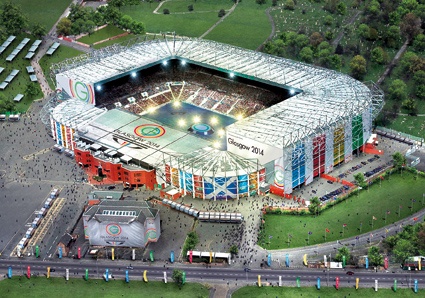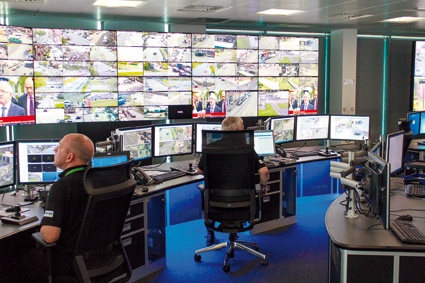Security Surveillance in Glasgow Operations Center
2014 is going to be a significant year for Glasgow, as it saw Scotland's biggest city host the 20th Commonwealth Games in July. Alongside the Games, the city - which is also the fo...



2014 is going to be a significant year for Glasgow, as it saw Scotland's biggest city host the 20th Commonwealth Games in July. Alongside the Games, the city - which is also the fourth largest in the UK - hosted three 60,000 capacity open-air concerts during Radio 1's Big Weekend and is also home to the 20th MTV Europe Music Awards (EMA) in November. How will the city's infrastructure cope with the influx of thousands of visitors to its major events, in addition to more than 600,000 residents? One way it will do so is by using the brand-new, multi-million pound Glasgow Operations Center (GOC) - one of the biggest projects of its kind in Scotland. Over 2,000 IP camera signals from Community Safety Glasgow and Traffic Control & Management Glasgow can be monitored and controlled on eighty-five 55-inch displays from eyevis. Their state-of-the-art technology is in use to make life in the city smarter and safer.
The facility brings together teams from Community Safety Glasgow's (CSG) CCTV operation and Traffcom, the Glasgow City Council team which monitors the city's road network, including the traffic lights and traffic cameras. With the facilities now pooled, CSG and Traffcom have joint access to the city's entire network of live and recorded CCTV footage.
Higher Efficiency Through Joining of Forces
At the center's opening, the leader of Glasgow City Council, Councilor Gordon Matheson said: "This facility houses our city's entire network of traffic cameras and public space CCTV, which will allow us to keep the city running and to keep people safe. Having both teams working together and operating under the same roof allows access to more information, more intelligence and quicker identification of incidents on our roads and streets. Glasgow will be open for business during the Games, but it will not be business as usual, and the opening of this center shows we're getting ready." Councilor Matheson was right; the city was transformed as over one million tickets were sold for the Games, so the timing of putting the GOC into operation was crucial.
One of the most interesting aspects of this installation is how it brings together the different strands of PSCCTV, the emergency services, traffic management and environmental control under one roof. Kalim Uddin, the GOC operations manager is a passionate technology advocate, and was involved in the project from the start. He said: "A key element in the operational center was to bring together various agencies and partners under one roof, all working in a more seamless approach, both from a traffic management and public safety point of view." With the facilities now pooled, CSG and Traffcom have joint access to the city's entire network of CCTV & traffic cameras. The council has found that the majority of Traffcom cameras (86%) are trained on areas previously not covered by CSG. Similarly, 32% of CSG's cameras now benefit Traffcom operations.
The GOC will be an ongoing project that will be steadily extended. In April 2014 after six weeks of operation only phase 1 was implemented. Phase 2 will mark the installation of significant upgrades to new digital cameras, new interactive mapping systems, traffic system upgrades and video analytics. Staff at CSG believe the true benefits of the center, in terms of reducing crime and anti-social behavior, will be seen in the next phases of the project once the new technology upgrades have been integrated.
Phil Walker, Managing Director of Community Safety Glasgow, said: "The new technology will give us vastly improved capabilities in the way we monitor crime. Also, from a traffic point of view it has given us wider access to cameras and assets, which helps us to reduce accidents, congestion and bottlenecks. Live images, live monitoring and live incident management will help us become more pro-active rather than reactive. We look forward to the continued development of the operations center in order to fully benefit from the superior functionality of the new systems."
Flexible Installation
The GOC is home to eighty-five eyevis 55-inch displays (in a range of different video wall configurations) and eleven video wall controllers, which show live streams from 440 CCTV cameras currently deployed around the city center. Eyevis UK was one of the video wall manufacturers involved with the project consultants, IBI, at the outset of the project over two years ago. The initial discussions between the manufacturer and the consultants centered on how they could build a control room that could handle thousands of IP streams. Alex Adleigh, sales director from integrator SSUK takes up the story. "When the client came to us originally, and we started the design and planning work, the original building plans only had space for one 19-inch rack unit. However, a suitable environmentally controlled equipment room was created to house the multiple 19-inch racks required."
The architecture of the new control center also had to be considered; the GOC is housed in a modern office building, built just two years previously. This had ramifications for the video wall installation because the floor of the building on which the GOC is situated has glass walls, which meant the screens couldn't be screwed to the wall. Every video wall in the installation sits on specially modified peerless carts. The difficulty was that when the operator is seated (as they are 24/7), the entire video wall wasn't high enough to be completely visible. SSUK had to detach the top section of the bracket from the back of the cart and get it remade in a work shop, which was then welded back onto the cart to make it two feet taller.
The real muscle of the operation is handled next door to the GOC in the server room, where eleven eyevis Netpix 4800 series video wall controllers, incorporating sixty-five daisy chained IPD32 decoders sit in racks, hard at work. Each one is capable of managing thirty-two D1 (720×576 resolution) IP streams, which gives the GOC the ability to handle up to almost 2,100 different feeds at once. This technology allows Glasgow to approach major events with confidence. Phil Walker added: "With the advent of the Commonwealth Games, we required a CCTV control room that is a leader in its class in terms of what it can provide. Glasgow is going to be in the limelight, so we wanted the Operations Center to reflect Glasgow in terms of where it's been and where it's going. The new operations center technology is a big part of that."
Multi-level Financing
The equipment for the project was bought under an outline contract, and went through ACCESS (a joint venture between Serco and Glasgow City Council), which provided the security systems. The nominated AV supplier, Scottish integrator SSUK, then built the video walls and AV systems in just eight weeks. The funding for the GOC comes from a mix of The Technology Strategy Board (part of the Department for Business, Innovation & Skills) and the Future Cities initiative funds. Glasgow City Council funded Part 1 of the initiative with £5.5m, and £12m from the Future Cities board was allotted for phase 2 and beyond.
In January 2013, Glasgow won a Future Cities competition, beating 30 other UK cities to win £24m of funding. Glasgow City Council demonstrated its ability to integrate transport, communications and other infrastructure to improve the city's economy, quality of life and reduce environmental impact better than anywhere else in Britain. The GOC is one of the first fruits of that program.
Business Partner
eyevis Gesellschaft für Projektions- und Großbildtechnik mbHHundsschleestr. 23
72766 Reutlingen
Germany
most read

GIT SECURITY AWARD 2026 - The winners have been announced!
GIT SECURITY AWARD 2026: The best safety and security solutions of the year - now an overview of all winners

Assa Abloy's battery-powered Aperio KL100 secures lockers
Boost workplace security and operational flexibility by securing more than just doors.

Machine & plant safety: The winners of category A at the GIT SECURITY AWARD 2026
GIT SECURITY AWARD 2026: Machine & plant safety - an overview of the most innovative solutions


Security management, building security & perimeter protection: the winners of category E at the GIT SECURITY AWARD 2026
GIT SECURITY AWARD 2026: Security management, building security & perimeter protection - an overview of the most innovative solutions








